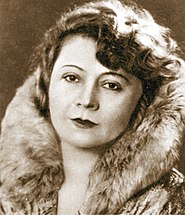Herminia Naglerowa
Herminia Naglerowa (sometimes wrote under the penname Jan Stycz, born 28 October 1890 in Zaliski near Brody, died 9 October 1957 in London) was a Polish writer and publicist.

Naglerowa studied history at the University of Lwów where she got her PhD. Subsequently she worked as a teacher, at first (1919) in Warsaw. Her first poems were published in the Viennese Kurier Polski in 1915. She also became known for her prose works, Czarny pies (1924, "The Black Dog") and Matowa Kres (1929) in which she combined realism with expressionism. She wrote the trilogy Krauzowie i inni (1930) ("The Family Krauz and others") which depicted the saga of a Galician family in the aftermath of the January Uprising. She also wrote youth literature; Ludzie prawdziwi ("Real People", 1935).
After the attack of Nazi Germany on Poland she moved back to Lwów, which soon came under Soviet occupation. She was arrested by the NKVD in 1940 and sent to the gulag in Kazakhstan.
She was released as a result of the Sikorski-Mayski Agreement signed between the Soviet Union and the Polish government-in-exile, and volunteered for the Anders Army in the East. Along with the army she left the Soviet Union in 1942. She served in the Media and Propaganda department and the Women's Auxiliary Service.[1] With the rank of corporal and later that of captain, she was present at all the battles of the Anders army. Herminia Naglerowa was the editor of the army's newspapers.
After the end of the war she did not return to then communist Poland but settled in Great Britain. She was the vice president of the Organization of Polish Writers Abroad. She wrote several novels based on her own experiences, Ludzie sponiewierani (1945, "Oppressed People"), Kazachstańskie noce (1958, "Kazakh Nights"), and "Sprawa Józefa Mosta" (1953, "The Case of Józef Most"). "Wspomnienia o pisarzach" (1960, "Memories of writers") and Wierność życiu (1967, "True to Life") were published posthumously.
In 1959, the Organization of Polish Writers Abroad endowed a prize in her name.
Her grave is located in the North Sheen Cemetery.[2]
Works
- Krauzowie i inni, Nakł. Oddziału Kultury i Prasy 2. Korpusu A.P., 1946
- Sprawa Jósefa Mosta, Gryf Publishers, 1953
- Loves and ambitions, Roy Publishers, 1954
- Mickiewicz żywy, 1955
- Wyspiański żywy, 1957
- Wierność życiu, Nakł. Polskiej Fundacji Kulturalnej, 1967
- Kazachstańskie noce, London, Biblioteka Polska Ośrodka Wydawniczego "Veritas", 1958
See also
References
- Ryszard Tylman, Koty marcowe, Wydawnictwo Nowy Swiat Publishing, Warsaw 2002, ISBN 83-88576-94-1. Page 80.
- Grodziska, Karolina (1995). Polskie groby na cmentarzach Londynu [Polish Graves in London Cemeteries] (in Polish). PAU. p. 423. ISBN 978-83-904926-8-1.